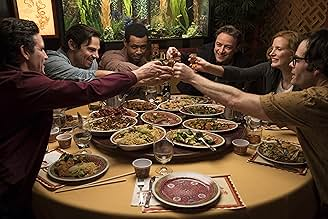It Chapter Two: A Worthy Conclusion?
The final installment of the Stephen King adaptation strives not to burst under the weight of its own grandeur, and largely succeeds.
Twenty-seven years after the events of the first chapter, the infernal clown Pennywise has resurfaced from the sewers of Derry, spilling blood once more. The members of the Losers’ Club have grown older and wiser, but they are still haunted by the repressed fears of their childhood – now compounded by the hardships of adulthood. They must reunite to finally put an end to the evil. They will also come to realize that their darkest and deepest secrets have grown to unimaginable proportions over time. And they suspect that not all of them will survive the encounter with the clown.

Many understood that after the incredible success of the first part of the new adaptation of Stephen King’s thousand-page novel from 1986, Warner Bros. would give director Andy Muschietti carte blanche to create the second part, and some were worried about this. Unfettered creative freedom does not always benefit genre mainstream. Especially when it comes to a film that has elevated the horror genre to the very top echelon of audience interest, a level that monsters of past decades could only dream of. Stephen King fans, niche horror publications, fan theories, and debates about fidelity to the original – all of this remained far below, shrouded in haze and almost indistinguishable. And “It” aspires to the stratosphere, to heights conquered only by superheroes in tight spandex. This is hinted at by the runtime, approaching three hours, and the generous strokes of CGI in every frame.

Muschietti handled this task not just decently. Muschietti was lucky that he was allowed to do whatever he wanted - and we are lucky that he knows how to do what he wants in a cool way (and he wants to do the right things). Within the framework of the horror blockbuster sequel, the director managed to lay down answers for those who, for some reason, would remain dissatisfied with what they saw. The film has flaws, as if he admits to the viewer, accept it, it is impossible to operate at such a level without them. But Muschietti cleverly solved the main problem of the sequel – to introduce adult actors into the narrative with minimal damage. We do not doubt for a second that Beverly Marsh, played by Sophia Lillis, grew into Jessica Chastain, and Bill Denbrough from Jaeden Lieberher grew into James McAvoy. The main success is the bespectacled chatterbox Richie Tozier, who, instead of Finn Wolfhard from “Stranger Things,” was played by Bill Hader, who in places seriously resembles Jack Nicholson. Therefore, the flashbacks and cross-cutting of scenes of adults and children, which many complained about in the second part, work so well – why not linger on your successful moment, not savor it.

Fear Factor
“It Chapter Two” works well in its main function – that is, it scares, and in places so much that you want to repeat after one of the young heroes his remark: “I think I shat myself.” Jump scares, which were abundant in the first part, are taken to some next level here, and will not allow for condescending attitudes. However, in addition to giant lumberjacks and a hellish funhouse, Muschietti also looks far beyond the comprehensible, into the otherworldly that is present in King’s novel. Here, the viewer will have to decide for himself whether he is ready and able to look so far along with the creators of the film.

However, the main reason for fear here is not infernal Halloween costumes, and not even the Pelevin-esque shining and gaping boundless expanses of evil. The horror here lies in the past, which never ended, and will devour your present and future until you realize this fact. And it shows, perhaps, the best way to end it – to realize this, to admit that, despite the enviable biceps, gray hair, or alcohol addiction, you, in fact, remained that young man who is afraid to go down into the dark basement.

Imperfections and the Ending
Without listing all the other advantages of the picture (and among them are several outstanding cameos, and masterfully installed gags, that is, the film copes with the entertainment function perfectly), let’s move on to the main shortcomings. Among them, the ending stands out, reminiscent in its degree of dissatisfaction of the fizzle with which J.J. Abrams’ “Super 8” ended, the same Spielbergian homage in spirit. But the clever Muschietti throughout the film persistently offers us the adult Denbrough, who has become a famous writer of genre bestsellers and a screenwriter of horrors based on them (doesn’t remind anyone?), whom only a lazy passerby does not kick for unsuccessful endings.
Moreover, Muschietti’s film most of all resembles the object that we most often see on the screen – a balloon. It is just as bright and visually appealing, it is immeasurably inflated and continues to grow in size (having already become larger than the novel on which it is based), we see the rope on which it is held, and we guess who is holding it. And the fate of the balloon is quite predictable – it is destined either to fly into the sky, or to burst with a bang, or to quietly release air and deflate. So far, it is flying.